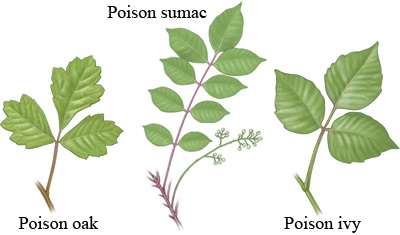
Overview
Poison ivy, poison oak, and poison sumac are plants that can cause a skin rash upon contact. The red, itchy rash often shows up in lines or streaks. It may cause fluid-filled blisters or large, raised hives.
The rash is caused by an allergic reaction to an oil in these plants. The rash may occur when your child touches a plant or touches objects that have come in contact with these plants. Common examples include clothing, pet fur, sporting gear, or gardening tools.
Your child can't catch or spread the rash by touching the rash or the blister fluid. The plant oil will already have been absorbed or washed off the skin. The rash may seem to be spreading because it's still developing from earlier contact or because your child has touched something that still has the plant oil on it.
Follow-up care is a key part of your child's treatment and safety. Be sure to make and go to all appointments, and call your doctor if your child is having problems. It's also a good idea to know your child's test results and keep a list of the medicines your child takes.
How can you care for your child at home?
- If your doctor prescribed a cream, use it as directed. If the doctor prescribed medicine, give it exactly as prescribed. Call your doctor if you think your child is having a problem with a medicine.
- Use cold, wet cloths to reduce itching.
- Take warm or cool baths with oatmeal bath products, such as Aveeno.
- Keep your child cool and out of the sun.
- Leave the rash open to the air.
- Wash all clothing or other things that may have come in contact with the plant oil.
- Avoid most lotions and ointments until the rash heals. Calamine lotion may help relieve symptoms of a plant rash. Use it 3 or 4 times a day.
To prevent exposure
- If you know that your child might go near poison ivy, oak, or sumac when playing outdoors, use a product (such as Ivy X Pre-Contact Skin Solution) that helps prevent plant oil from getting on the skin. These products come in lotions, sprays, or towelettes. You put the product on the skin right before your child goes outdoors.
- If you did not use a preventive product and your child has had contact with plant oil, clean it off your child's skin with an after-contact product as soon as possible. These products, such as Tecnu Original Outdoor Skin Cleanser, can also be used to clean plant oil from clothing or tools.
When should you call for help?
Call your doctor now or seek immediate medical care if:
- Your child has signs of infection, such as:
- Increased pain, swelling, warmth, or redness.
- Red streaks leading from the rash.
- Pus draining from the rash.
- A fever.
Watch closely for changes in your child's health, and be sure to contact your doctor if:
- Your child does not get better as expected.
Where can you learn more?
Go to http://www.healthwise.net/patientEd
Enter R114 in the search box to learn more about "Poison Ivy, Oak, and Sumac in Children: Care Instructions".
Current as of: December 4, 2024
Author: Ignite Healthwise, LLC Staff
Clinical Review Board
All Ignite Healthwise, LLC education is reviewed by a team that includes physicians, nurses, advanced practitioners, registered dieticians, and other healthcare professionals.

